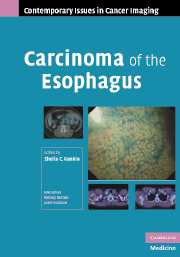Book contents
- Frontmatter
- Contents
- Contributors
- Series foreword
- Preface to Carcinoma of the Esophagus
- 1 Epidemiology and Clinical Presentation in Esophageal Cancer
- 2 Pathology of Esophageal Cancer
- 3 Recent Advances in the Endoscopic Diagnosis of Esophageal Cancer
- 4 Endoscopic Ultrasound in Esophageal Cancer
- 5 CT in Esophageal Cancer
- 6 FDG-PET and PET/CT in Esophageal Cancer
- 7 The Role of Surgery in the Management of Esophageal Cancer and Palliation of Inoperable Disease
- 8 Chemotherapy and Radiotherapy in Esophageal Cancer
- 9 Role of Stents in the Management of Esophageal Cancer
- 10 Lasers in Esophageal Cancer
- Index
- References
10 - Lasers in Esophageal Cancer
Published online by Cambridge University Press: 08 August 2009
- Frontmatter
- Contents
- Contributors
- Series foreword
- Preface to Carcinoma of the Esophagus
- 1 Epidemiology and Clinical Presentation in Esophageal Cancer
- 2 Pathology of Esophageal Cancer
- 3 Recent Advances in the Endoscopic Diagnosis of Esophageal Cancer
- 4 Endoscopic Ultrasound in Esophageal Cancer
- 5 CT in Esophageal Cancer
- 6 FDG-PET and PET/CT in Esophageal Cancer
- 7 The Role of Surgery in the Management of Esophageal Cancer and Palliation of Inoperable Disease
- 8 Chemotherapy and Radiotherapy in Esophageal Cancer
- 9 Role of Stents in the Management of Esophageal Cancer
- 10 Lasers in Esophageal Cancer
- Index
- References
Summary
Introduction
Lasers are sophisticated sources of monochromatic light. In the near-infrared part of the optical spectrum, laser light penetrates living tissue well and can be transmitted via thin, flexible fibers through the working channel of endoscopes. High-power shots of light turn into heat, which vaporizes tissue and coagulates the underlying layers. This effectively debulks advanced cancers. At much lower powers, it is possible to coagulate a larger volume of tissue without vaporization.
Laser can also deliver a photodynamic effect where there is no increase in tissue temperature, but the light activates a previously administered photosensitizing drug. This causes the release of highly reactive singlet oxygen, which causes cell death by necrosis and apoptosis over a prolonged period. This can be used to completely eradicate small tumors (Table 10.1).
Palliation of advanced cancers
Most patients with cancer of the esophagus or gastric cardia present with locally advanced disease and therefore are unsuitable for surgery. One of the main aims of treatment is to relieve dysphagia as simply and rapidly as possible. The most widely used endoscopic approach is tumor dilatation and insertion of an expanding metal stent although many oncologists do not advocate endoscopic therapy at all, relying on radiotherapy or chemotherapy to improve dysphagia. It is clear that oncological therapy alone is more suitable only for mild dysphagia, but for patients who are only able to tolerate liquids, an endoscopic therapy is better.
- Type
- Chapter
- Information
- Carcinoma of the Esophagus , pp. 145 - 150Publisher: Cambridge University PressPrint publication year: 2007



